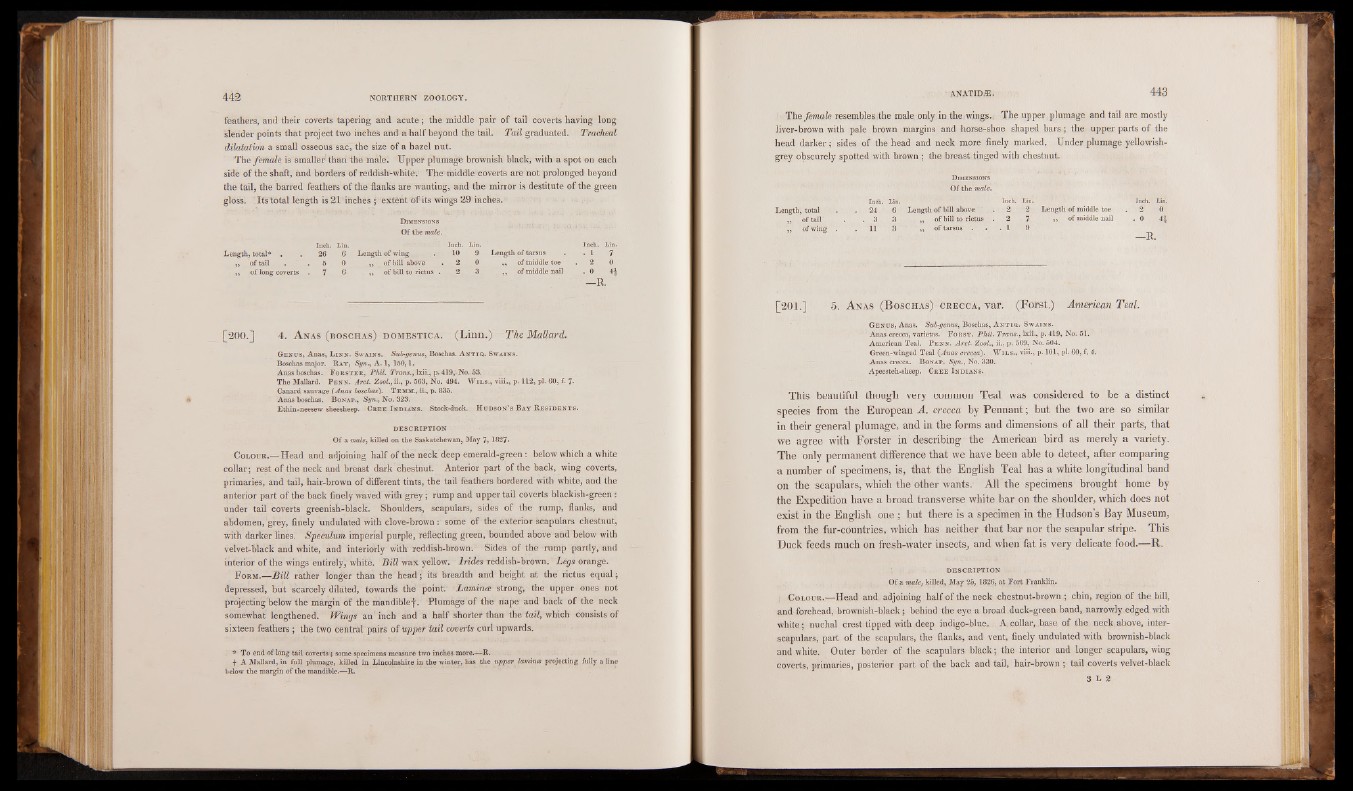
feathers, and their coverts tapering and acute; the middle pair of tail coverts having long
slender points that project two inches and a half beyond the tail. Tail graduated. Tracheal
dilatation a small osseous sac, the size of a hazel nut.
The female is smaller than the male. Upper plumage brownish black, with a spot on each
side of the shaft, and börders of reddish-white'. The middle coverts are not prolonged beyond
the tail, the barred feathers of the flanks are wanting, and the mirror is destitute of the green
glóssl Its total length is 21 inches j extent of'its wings 29 inches.
Inch. Lin.
D im en sio n s
Of the male.
L in.
Length, total* . 2 6 6 Length of wing 10 9 Length of tarsus . 1 7
,, of tail 5 0 „ _ of bill above 2 0 „ of iniddle toe 2 0
„ of long coverts . 7 6 „ of bill to rictus . 2 3 „ o f middle nail . 0 4£
P I P R .
[200.] 4. A nas (boschas) domestica. . (L inn.) The Mallard.
Genus, Alias, Lin n. Swains. Sub-genus, Boschas. Antiq. Swains.
Boschas major. Rat, Syn., A. 1, 150,1.
Anas boschas. Forster, Phil. Trans., lxii., p. 419,-No. 53.
The Mallard. P enn. Arct. Zool., ii., p. 563, No. 494. W its., viii., p. 112, pi. 60, f. 7*
Canard sauvage (Anas boschas). TEMM.,.ii., p. 835.
Anas boschas. Bonap., Syn., No. 323.
Ethin-neesew sheesheep. Cree Indians. Stock-duck. Hudson’s Bay Residents.
DESCRIPTION
Of a male, killed on the Saskatchewan, May 7, 1827.
C olour.— Head and adjoining half of the neck deep emerald-green: below which a white
collar; rest of the neck and breast dark chestnut. Anterior part of the back, wing coverts,
primaries, and tail, hair-brown of different tints, the tail feathers bordered with white, and the
anterior part of the back finely waved with grey; rump and upper tail coverts blackish-green :
under tail coverts greenish-black. Shoulders, scapulars, sides of the rump, flanks, and
abdomen, grey, finely undulated with clove-brown: some of the exterior scapulars chestnut,
with darker lines. Speculum imperial purple, reflecting green, bounded above and below with
velvet-black and white, and interiorly with reddish-brown. Sides of the rump partly, and
interior of the wings entirely, white. Bill wax yellow. Irides reddish-brown. Legs orange.
Form.—Bill rather longer than the head; its breadth and height at the rictus equal;
depressed, but scarcely dilated, towards the point. Lamince strong, the upper ones not
projecting below the margin of the mandiblef. Plumage of the nape and back of the neck
somewhat lengthened. TVingsf an'inch" and a half shorter than the tail, which consists of
sixteen feathers ; the two central pairs of upper tail coverts curl upwards.
. * To end of long tail covertS ; some specimens measure two inches-more.—R.
A Mallard, in full plumage, killed in Lincolnshire in the winter, has the upper lamina projecting fully a line
below the margin of the mandible.—R.
ANATIDiE. 443
The female resembles ithe male, only in the wings. | The upper; plumage and tail are mostly
liver-brown with pale brown margins and horse-shoe shaped bars; the upper parts of the
head darker; sides of the head and neck more finely marked. Under plumage yellowish-
grey obscurely spotted with brown ; the breast tinged with chestnut.
Dimensions
Of the male.
Length, total .. 24 6 Length of bill above
Inch. Lin.
. 2 2 Length of middle toe
Inch. Lin.
. 2 0
„ of tail ’ • 3 3 „ of bill to rictus . 2 7 ,, of middle nail . 0 A\
,, of wing 11 3 ,, of tarsus . . 1 9
— R .
[201.].$ 5. A nas (B oschas) ckegca, var. ji|jForst.) American Teal.
Genus, Anas. Sub-genus,. Boschas, An t iq .. Swains.
Anas crecca, varietas. Forst. Phil. Trans., lxii., p. 419, No. 51.
American Teal. Penn. Arct. Zool., ii., p. 569, No. 504.
Green-winged Teal (Anas crecca). Wins., viii., p. 101, pi. 60, f. 4.
Anas crecca. Bonap. Syn., No. 330.
Apeesteh-sheep. Cree Indians.
This beautiful though very common Teal was considered to be a distinct
species from the European A. crecca by Pennant; but the two are so similar
in their general plumage, and in the forms and dimensions of all their parts, that
we agree with Forster in describing the American bird as merely a variety.
The only permanent difference that we have been able to detect, after comparing
a number of specimens, is, that the English Teal has a white longitudinal band
on the scapulars, which the other wants.- All the specimens brought home by
the Expedition have a broad transverse white bar on the shoulder, which does not
exist in the English one; but there is a specimen in the Hudson’s Bay Museum,
from the fur-countries, which has neither that bar nor the scapular stripe. This
Duck feeds much on fresh-water insects, and when fat is very delicate food.—R.
DESCRIPTION
Of a male, killed, May 25, 1826, at Fort Franklin.
: C olo u r .—Head and adjoining half of the neck chestnut-brown ; chin, region of the bill,
and forehead, brownish-black; behind the eye a broad duck-green bandj narrowly edged with
white; nuchal crest.tipped with deep indigo-blne. A,collar,base of the neck.above, interscapulars,
part of the scapulars, the flanks, and vent, finely undulated with brownish-black
and white. Outer border of the scapulars black; the interior and longer scapulars, wing
coverts, primaries, posterior part of the back and tail, hair-brown ; tail coverts velvet-black
3 L 2
HfH